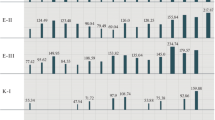Abstract
Experiments are reported in which genetically different strains of Drosophila willistoni compete with D. pseudoobscura. The competition was studied at three temperatures, 20°, 22°, and 25°C. The outcome of the competition depends on the genetic constitution of the competing species, but at 25° and 22°C D. willistoni flies are generally stronger competitors than D. pseudoobscura, while at 20°C D. pseudoobscura generally has a competitive advantage. There is a significant interaction between genotype and temperature; the strain RP3 is the weakest competitor of all D. willistoni strains at 22° and 25°C, but not at 20°C; the strain M18 is the best competitor at 20° and 22°C but not at 25°C.
The performance of the four strains of D. willistoni was measured in two more ways. First we estimated their Darwinian fitness relative to other genotypes of the same species. Second, we measured the average population size of each strain in pure culture. There is no significant correlation between population size in pure culture and either competitive fitness or Darwinian fitness. There is, however, a strong positive correlation between Darwinian fitness and interspecific competitive fitness.
It is pointed out that natural selection leads to an increase in the average Darwinian fitness of a population but not necessarily to an increase in its adaptedness to the environment. Yet the synthetic theory of evolution assumes that the genes and genotypes favored by natural selection are usually those which increase the adaptedness of their carriers to the environments where they live. The correlation between Darwinian fitness and adaptedness needs to be studied experimentally.
Similar content being viewed by others
References
Ayala, F. J. (1969a). Genetic polymorphism and interspecific competitive ability in Drosophila. Genet. Res. Camb. 14: 95–102.
Ayala, F. J. (1969b). An evolutionary dilemma: fitness of genotypes versus fitness of populations. Canad. J. Cytol. Genet. 11: 439–456.
Ayala, F. J. (1970). Population fitness of geographic strains of Drosophila serrata as measured by interspecific competition. Evolution 24: 483–494.
Barker, J. S. F. (1963). The estimation of relative fitness of Drosophila populations. III. The fitness of certain strains of D. melanogaster. Evolution 17: 138–146.
Barker, J. S. F. (1965). The estimation of relative fitness of Drosophila populations IV. Experiments on D. pseudoobscura. Genetics 51: 747–59.
Dawson, P. S. (1969). A conflict between Darwinian fitness and population fitness in Tribolium “competition” experiments. Genetics 62: 413–419.
Dobzhansky, Th. (1968). On some fundamental concepts of Darwinian biology. Evol. Biology 2: 1–34.
Fujii, K. (1969). Studies on interspecies competition between the azuki bean weevil and the southern cowpea weevil. IV. Competition between strains. Res. Pop. Ecology 2: 84–91.
Lerner, I. M. & F. K. Ho (1961). Genotype and competitive ability of Tribolium species. Amer. Naturalist 95: 329–343.
Mourão, C. A. & F. J. Ayala. Fitness versus adaptedness in experimental populations of Drosophila willistoni (in prep.)
Mourão, C. A. & W. W. Anderson. A test for the importance of heterosis in populations of Drosophila willistoni. (in prep.)
Park, T. (1954). Experimental studies of interspecies competition. II. Temperature, humidity, and competition in two species of Tribolium. Physiol. Zool., 27: 177–238.
Park, T., P. H. Leslie & D. B. Mertz (1964). Genetic strains and competition in populations of Tribolium. Physiological Zoology 37: 97–162.
Pavan, C., A. R. Cordeiro, N. Dobzhansky, Th. Dobzhansky, C. Malogolowkin, B. Spassky & M. Wedel (1951). Concealed genetic variability in Brazilian populations of Drosophila willistoni. Genetics 36: 13–30.
Strickberger, M. W. (1963). Evolution of fitness in experimental populations of Drosophila pseudoobscura. Evolution 17: 40–55.
Author information
Authors and Affiliations
Additional information
This work was supported by NSF grant GB-12562 (International Biological Program), AEC contract AT-(30-1)-3096, and PHS Career Development Award K3GM 37265 to F. J. Ayala. The senior author's stay in New York was financed in part by Research Fellowship 2-12861 from the Panamerican Union.
Rights and permissions
About this article
Cite this article
Mourão, C.A., Ayala, F.J. Competitive fitness in experimental populations of Drosophila willistoni . Genetica 42, 65–78 (1971). https://doi.org/10.1007/BF00154841
Received:
Issue Date:
DOI: https://doi.org/10.1007/BF00154841




